Hot off Gigabytes announcement of their latest workstation motherboard release, the MW70-3S0. GIGABYTE Presents Its Latest Dual Socket Workstation Motherboard, we now have one in the Lab to test for this review so let’s take a look at Gigabytes latest dual socket LGA2011-3 workstation motherboard.
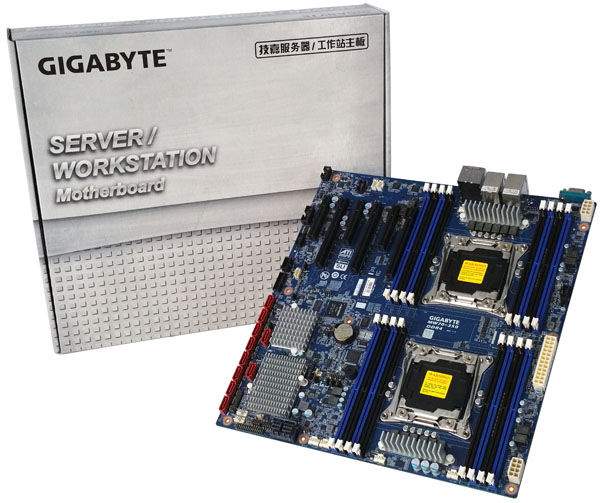
The MW70-3S0 is similar to the MD70-HB0 Server Motherboard that we have reviewed months ago. The design includes many of the same features. However the Gigabyte MW70-3S0 has been adapted for workstation duties by offering support of 3-way NVIDIA SLI & AMD CrossFireX technologies, this board can support up to 3 full size GPU’s running at full PCI-Express Gen3 x16 bandwidth. It does use the same LSI SAS 3008 controller chip but 10 Gigabit Ethernet was removed.
Gigabyte MW70-3S0 Specifications
- Intel Xeon processor E5-1600 V3 & E5-2600 V3 product families
- 16x RDIMM/LRDIMM ECC DDR4 DIMM slots
- Supports 3-Way NVIDIA SLI / AMD CrossFireX
- 2x GbE LAN port (Intel I210)
- 2x Mini-SAS (for 8x SAS 12Gb/s ports)
- Raid Support options: LSI SAS 3008 SAS3 (12Gbps) controller (8 Ports); RAID 0, 1, 1E, 10
- 10x SATA III 6Gb/s
- Realtek ALC887 controller supports 2/4/5.1/7.1 channel configurations
- 2x USB 3.0 + 2x USB 2.0 ports
- 1x USB 3.0 header + 1x USB 2.0 header dimensions: 17.25” x 3.47” x 28.75”
- Video Integrated in Aspeed AST2400-VB
- From Factor: E-ATX / SSI EEB, 305W x 330D (mm)
Packaging
The MW70-3S0 comes in an retail box that is typical for Gigabyte products in this class. Inside the box we find the motherboard that is protected by foam inserts and an accessory compartment underneath. Opening the accessory compartment we find the needed SLI and Crossfire connectors, the IO back plate and a driver DVD.
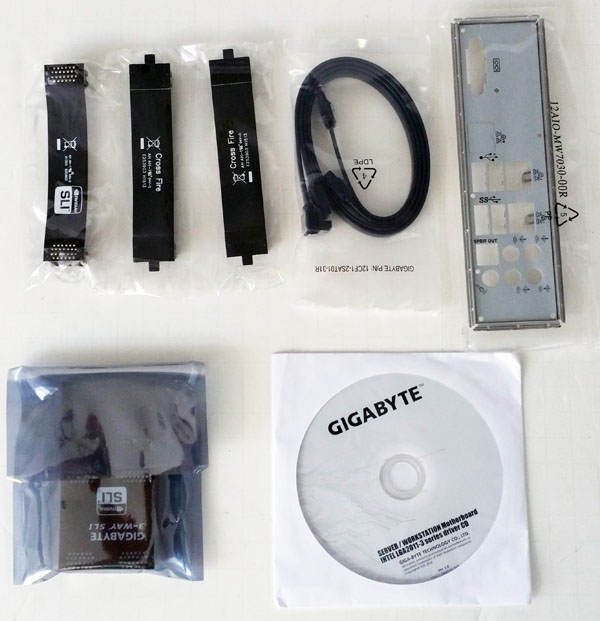
The accessories posted on Gigabytes website are:
- 1x MW70-3S0
- 1x User manual
- 1x Driver CD
- 1x I/O shield
- 2x SATA III 6Gb/s cables (500mm)
- 1x CrossFire bridges
- 1x 2-SLI bridge
- 1x 3-SLI bridge
Close look at the MW70-3S0
Here we see a top down view of the MW70-3S0. The expanded number of SATA ports next to the left edge of the motherboard we find common on many different types of motherboards using the Intel C612 chipset.
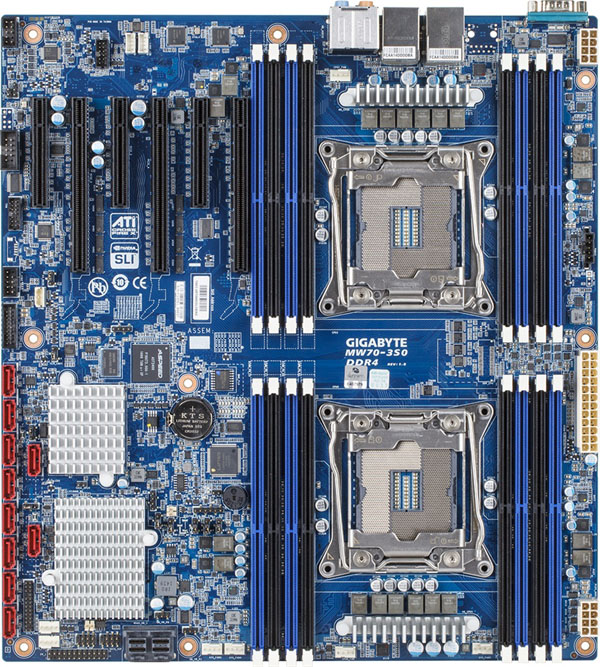
One problem with this layout is if you install three full sized GPU’s, the 3rd GPU will cover some of the ports. You can use a 90 degree SATA cable on these ports to get by if you need these ports. In most builds this is not a problem as the first row of ports is generally clear of the GPU’s.
At the lower front left corner of the motherboard we get a look at the storage ports used on the MW70-3S0.
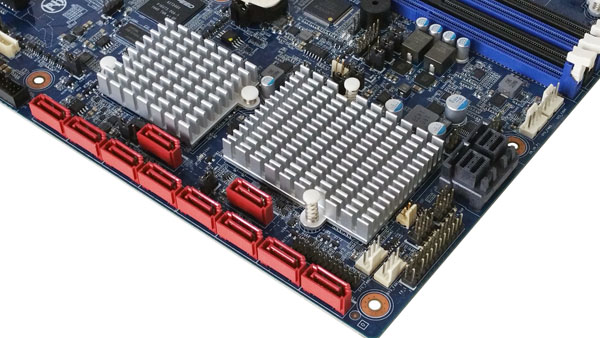
The SATA ports here are colored red and come off the C612 chipset. These ports are all SATA 3 6Gb/s connectors. The bottom 4 come off the SSATA line of the C612 while the rest come off of the ACHI. The large aluminum heat sink provides cooling for the LSI SAS 3008 controller and just above is the heat sink for the C612 chipset.
Over at the front of the motherboard we find the 2x Mini-SAS connectors with the Front Panel Header, Fan Headers and USB Headers.
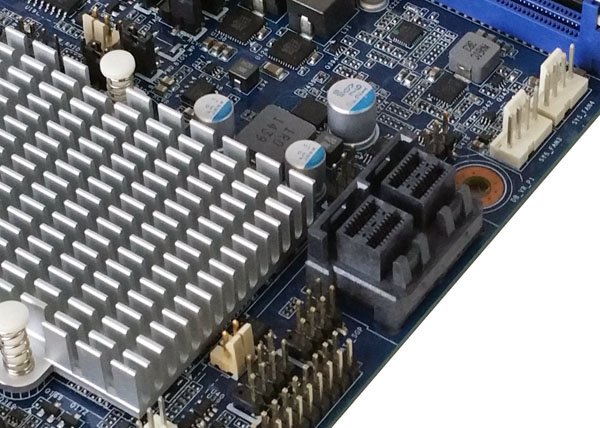
Here we get a look at the 2x Mini-SAS connectors (for 8 x SAS 12Gb/s) which comes off of the LSI SAS 3008 controller, it can provide connections to 8 drives and supports RAID 0, 1, 1E, 10.
Looking at the PCIe slot area we find it is clean and has no extra clutter between the slots.
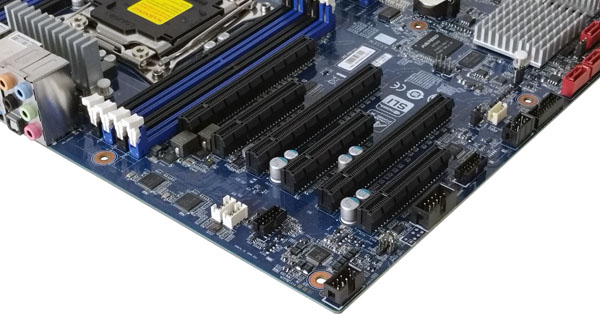
Here we see the standard PCIe layout for the MW70-3S0. In this arrangement PCIe slot #6 sits right next to the memory slots which is a tight fit. Be sure to check for clearance if your RAM sticks include heat spreaders.
At the back of the motherboard we find a serial Port, 2x USB 2.0, 2x USB 3.0, 5x audio jacks plus S/PDIF optical output and 2x Gigabit Ethernet LAN ports.
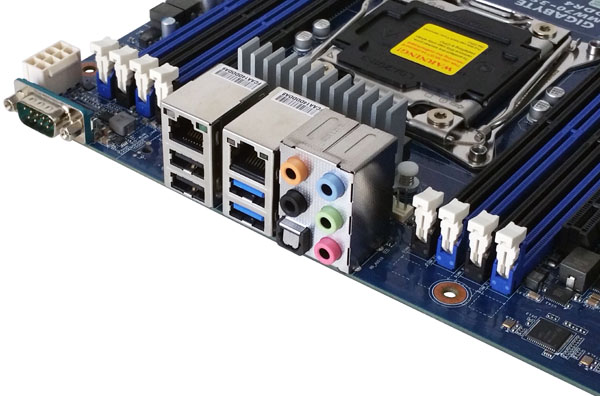
For a workstation we would like to see more USB ports as two of these ports would be used by a Keyboard/Mouse leaving only 2x USB 3.0 for external devices. Often times we have many things connected here, from printers to scanners and other items, so the more USB ports the better. One can use a USB 3.0 hub, however that does add additional cost.
The right hand side of the motherboard is where we find the power connections.
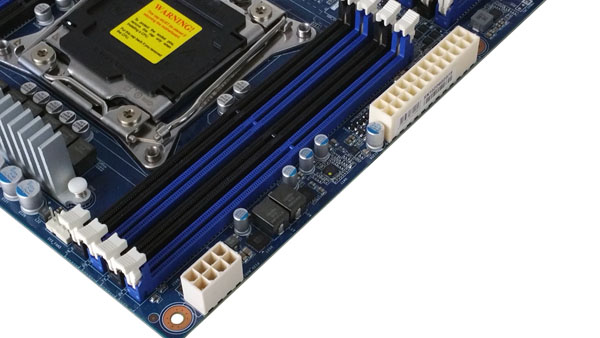
The power connectors on the MW70-3S0 are well spaced out to avoid connection clutter. The third power connection is at the far rear of the motherboard. Spacing for these connectors is good but might cause some issues with different power supplies. Be sure to check you case and PSU layout.
BIOS
Access to the BIOS using Gigabytes remote management is simple and just like any server board we have used. For our testing we use default optimized settings for all our tests.
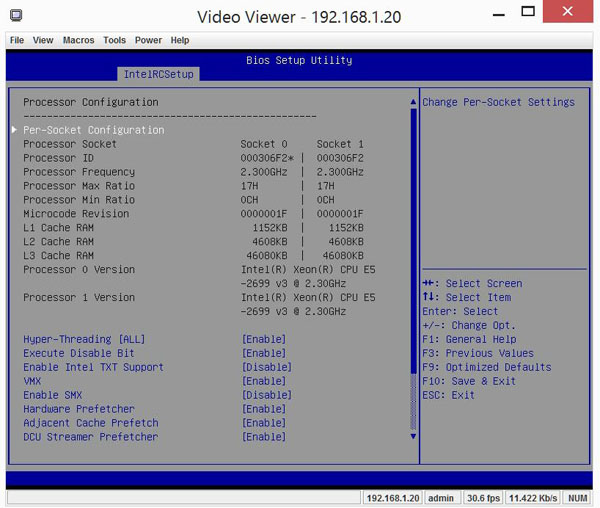
The MW70-3S0 does have settings for NVMe drive configurations and Intel Thunderbolt.
Test Configuration
Our test bed is typical of all motherboard reviews we have completed. BIOS settings are set to default optimized.
- Processors: 2x Intel Xeon E5-2699 V3 (18 cores each)
- Memory: 16x 16GB Crucial DDR4 (256GB Total)
- Storage: 1x SanDisk X210 512GB SSD drive for the OS.
- Graphics: 1x Nvidia K5200
- Cooling: 2x Noctua NH-U9DX-i4
- PSU: Thermaltake Toughpower 1500W Gold
- Operating Systems: Ubuntu 14.04 LTS and Windows 8.1 Pro
AIDA64 Memory Benchmark
AIDA64 memory bandwidth benchmarks (Memory Read, Memory Write, and Memory Copy) measure the maximum achievable memory data transfer bandwidth.
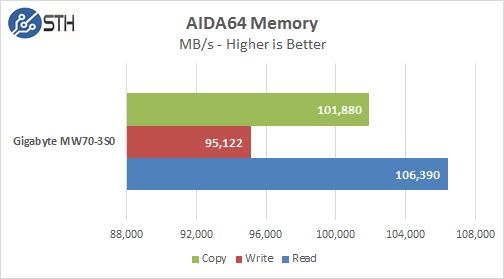
With 16x 16GB DDR4 memory sticks installed we saw memory speeds of 1866MHz with performance that matched many motherboards like this that we have tested. The Gigabyte MD70-HB0 does have slightly better performance than this board does.
Memory Latency ranged at ~87ns and our average systems using 16x 16GB DIMM’s ranged about ~78ns.
SPEC CPU2006
SPEC CPU2006v1.2 measures compute intensive performance across the system using realistic benchmarks to rate real performance.
In our testing with SPEC CPU2006 we use the basic commands to run these tests.
” Runspec –tune=base –config=servethehome.cfg ,” then ” int ,” or ” fp .”
To do multi-threaded, we add in ” –rate=72.”
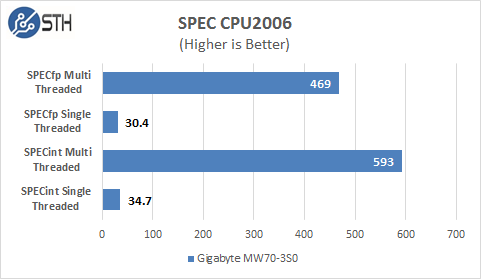
Our CPU2006 test results are also impressive for a comparable system. Single threaded results are boosted by a Turbo speed of 3.6Ghz on the E5-2699 V3’s. With 36 cores / 72 threads we also get good multi-threaded results. Workstation systems like this might be better served with E5-2687W V3’s as they do have a faster stock speed at the expense of extra cores.
Linux-Bench Test
Our Linux-Bench is a test suite scripts common Linux benchmarks and provides a consistent and easy to run methodology. One can compare these tests to hundreds of other configurations in the Linux-Bench database but also with sites such as Tom’s Hardware and Anandtech that use the script.

An example of our Linux-Bench run from this configuration can be found here. Gigabyte MW70-3S0 Linux-Bench Results
The Intel Xeon E5-2699 V3 processors are rated at 145 watts TDP and are equipped with 18 The Intel Xeon E5-2697 V3 processors are rated at 145 watts TDP and are equipped with 14 cores at 2.3GHz/3.6GHz Turbo speed.
SPECwpc Workstation Benchmark
SPECwpc_v1.0.2 is a workstation benchmark that measures key aspects of workstation applications.
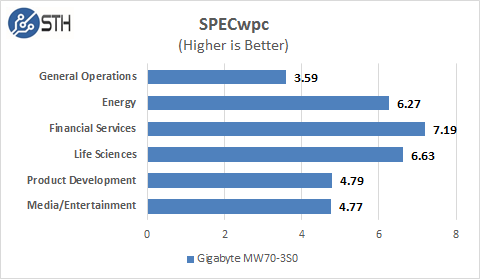
SPECwpc results can vary by a large amount depending on the GPU and Storage drives used. Several results can be boosted by using a higher end GPU. The MW70-3S0 does have very good results for Financial Services and Life Sciences.
GpuTest
GpuTest is a cross-platform (Windows, Linux and Max OS X) GPU stress test and OpenGL benchmark. GpuTest comes with several GPU tests including some popular ones from Windows’world (FurMark or TessMark).
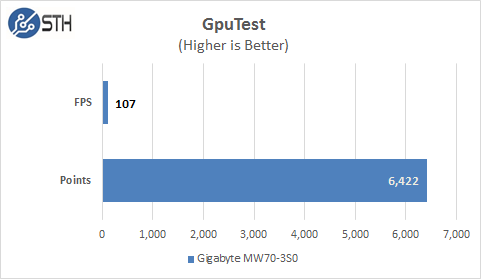
GpuTest is a graphics card benchmark and for our tests we used FurMark based stress test (OpenGL 2.1 or 3.2).
Power Tests
For our power testing needs we use a Yokogawa WT310 power meter which can feed its data through a USB cable to another machine where we can capture the test results. We then use AIDA64 Stress test to load the system and measure max power loads.
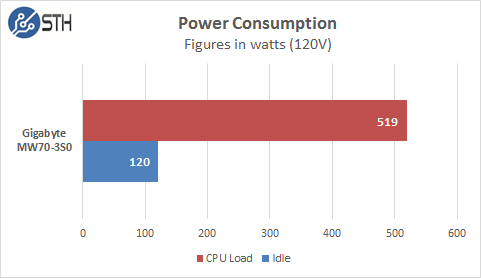
The average idle power use of the MW70-3S0 was ~120watts, we did peak out at 519watts with ADIA64 Stress Test that we use for load testing. We would like to see lower peak power use on this motherboard, many fall into the 500watt range so it’s not that high to worry about.
Conclusion
The MW70-3S0 does not include a lot of extra fluff that you do not need, features are specific and serve a useful purpose so you do not end up with a high price board that half of the feature list you never use.
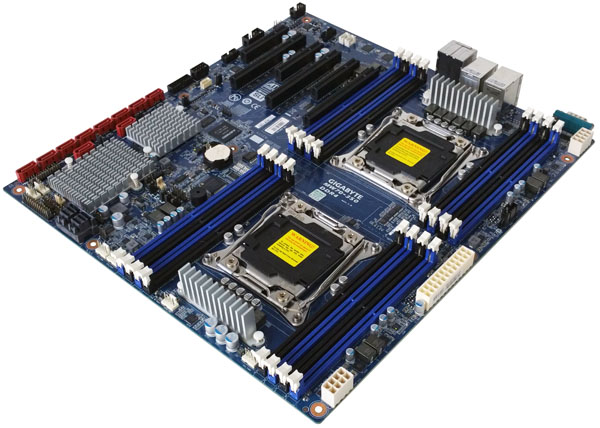
The retail box for the MW70-3S0 is not impressive as other brands, Gigabyte produces a retail package aimed at lower costs. Normally this box is discarded after taking the motherboard out so it is fit for its purpose. Performance matches other workstation boards so this is a smart move on Gigabytes part.
There are only a handful of dual socket workstation motherboards that allow overclocking and Gigabyte does not appear to have one. We would like to see a dual socket workstation board built using the GA-X99-SOC Force style and features. We think would be a great addition to Gigabyte’s line up and offer compelling choices to builders and OEM’s that seem only have one choice for an enthusiast class dual socket workstation board. These dual socket motherboards only allow for small BCLK adjustments but extra performance can be tapped with these and in todays market every edge counts. But aside from OC features the MW70-3S0 has everything you need to build an impressive workstation.
We are impressed with the performance of the MW70-3S0 and we suspect a lower price point that can save you a significant amount in your workstation costs.

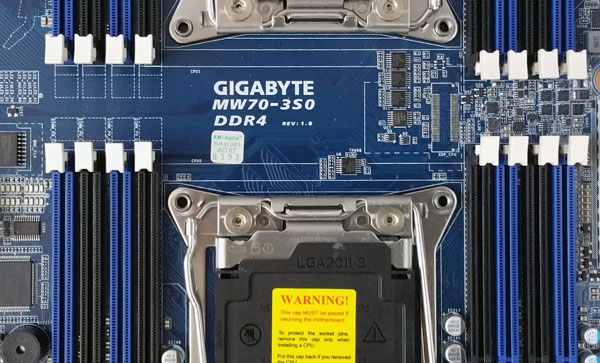


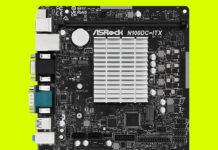
If you going to do a review of such a big board with a big price, take the time to do it right and with plenty of detail. The article is rushed and missing any real detail, especially for a Workstation system.
Overclocking is NOT a WS requirement and far from it’s intended purpose of being a workstation. This means STABLE and a workhorse.
I am over seeing bloody Linux test-benches, Most using these sorts of boards will be in a Windows environment using commercial software, certainly not developed for Linux.
Bench it with tools, software and apps that will use all the cores & GPU to really show what a 2P board is designed for.
I agree, what are we comparing this motherboard to and under what conditions?
run real tests using apps that test the motherboard functions and performance against another motherboard of the same class for example, the ASUS Z10PE-D8 WS Motherboard. (I have one of these I am using to type this)
See which performs better.
I agree that on board USB 3 ports are very handy as I have 9 devices currently plugged into mine. (I am using a couple of hubs too)
Reordering the pci sockets would be the smartest thing Gigabyte could do with this board. Having the pci sockets inverted in order would allow the top two sockets to be used when dual Graphics cards are used.
The CPU2 can only get hot air from CPU1, which addes the pressure to the heatsink and fan for CPU2. Hope this won’t be an issue for TDP 145W CPUs. If you could do an AIDA64 stress test and shows the CPU temperatures and fan speed (noise level), that would be helpful.